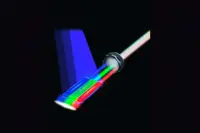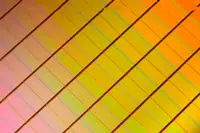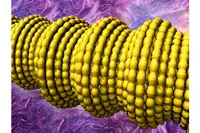Electronics News
Archive : 29 July 2015 год
 Researchers at Arizona State University claim to have created the first lasers that can shine light over the full spectrum of visible colours. The device's inventors suggest the laser could find use in visual displays, lighting and a laser-based version of Wi-Fi.
Researchers at Arizona State University claim to have created the first lasers that can shine light over the full spectrum of visible colours. The device's inventors suggest the laser could find use in visual displays, lighting and a laser-based version of Wi-Fi.
Previous research has created lasers that usually only emit one colour of light, red, green, blue, etc. Creating a structure capable of emitting red, green, and blue all at once has proven difficult because it requires combining very different semiconductors. Growing mismatched crystals next to one other often results in defects.
But now scientists say they've overcome that problem. The heart of the new device is a sheet, nanometers thick, made of a semiconducting alloy of zinc, cadmium, sulphur, and selenium. The sheet is divided into three segments. When excited with a pulse of light, the segments rich in cadmium and selenium gave off red light; those rich in cadmium and sulphur emitted green light; and those rich in zinc and sulphur glowed blue.
The researchers grew this alloy in stages, carefully varying the temperature and other growth conditions over time. By controlling the interplay between the vapour, liquid, and solid phases of the different materials that made up this nanosheet, they ensured that these crystals could coexist.
The scientists can individually target each segment of the nanosheet with a light pulse. Varying the power of the light pulses that each section received tuned how intensely they shone, allowing them to produce 70% more perceptible colours than the most commonly used light sources.
Lasers are claimed to be more energy-efficient than LEDs: While LED-based lighting produces up to about 150 lumens per watt of electricity, lasers could produce more than 400 lumens per watt, says Cun-Zheng Ning, professor in the School of Electrical, Computer and Energy Engineering, who worked on the laser. In addition, he says that white lasers could also lead to video displays with more vivid colours and higher contrast than conventional displays.
Another important potential application could be 'Li-Fi', the use of light to connect devices to the Interenet. Li-Fi could be 10 times faster than today's Wi-Fi, but "the Li-Fi currently under development is based on LEDs," Ning says. He suggests white-laser based Li-Fi could be 10 to 100 times faster than LED-based Li-Fi, because the lasers can encode data much faster than white LEDs.
In the future, the researchers plan to explore whether they can excite these lasers with electricity instead of with light pulses.
Author
Tom Austin-Morgan
Source: www.newelectronics.co.uk
 All 210 exhibition stands at the 2015 EDS events have now been allocated and visitor registration has opened for the UK's largest exhibition and conference for the Design Engineering community. EDS combines the Engineering, Electronics and Embedded Design Shows, which return to the Jaguar Exhibition Halls, Ricoh Arena, Coventry, on 21-22 October.
All 210 exhibition stands at the 2015 EDS events have now been allocated and visitor registration has opened for the UK's largest exhibition and conference for the Design Engineering community. EDS combines the Engineering, Electronics and Embedded Design Shows, which return to the Jaguar Exhibition Halls, Ricoh Arena, Coventry, on 21-22 October.
2015 will be the biggest edition of the show since its launch in 2012, with 210 exhibitors confirmed and record visitor numbers anticipated. Visitors will have the opportunity to choose from 24 keynote presentations brought together by the editors of New Electronics, Eureka and Engineering Materials. Speakers are drawn from leading industry experts including ARM, EE, Cambridge Consultants, Ben Ainslie Racing, Romax and many more.
EDS is the only show in the UK that caters specifically for design engineers from all disciplines, making it the 'must attend' event for the design engineering community. The full exhibition hall will feature the latest technologies and British design innovations as well as four workshop theatres where delegates can earn CPD points and hear about trends and issues driving their industry. EDS provides a dynamic environment in which to interact with suppliers, customers and colleagues.
"Time is a precious commodity for all design engineers and any time out of the office needs justification. The EDS events continue to deliver outstanding conference content backed by the most comprehensive UK exhibition of its type," said Ed Tranter, managing director at organiser Mark Allen Exhibitions. "All three shows include a high level conference and free practical workshops in addition to the exhibition, accommodating the needs of all UK design engineers under one roof."
Author
Tom Austin-Morgan
Source: www.newelectronics.co.uk
 Intel and Micron have produced a memory technology that they claim is up to 1000 times faster than NAND flash. 3D XPoint is the first new class of 'mainstream' memory technology since the introduction of NAND flash in 1989.
Intel and Micron have produced a memory technology that they claim is up to 1000 times faster than NAND flash. 3D XPoint is the first new class of 'mainstream' memory technology since the introduction of NAND flash in 1989.
3D XPoint technology is said to combine the performance, density, power, non-volatility and cost advantages of all available memory technologies on the market today. As well as being faster, Intel and Micron claim the technology also has up to 1000 times greater endurance than NAND, and is 10 times denser than conventional memory.
"One of the most significant hurdles in modern computing is the time it takes the processor to reach data on long-term storage," said Mark Adams, president of Micron. "This new class of non-volatile memory is a revolutionary technology that allows for quick access to enormous data sets and enables entirely new applications."
Following more than a decade of research and development, 3D XPoint was built from the ground up to address the need for non-volatile, high-performance, high-endurance and high-capacity storage and memory at an affordable cost. It is claimed to allow much more data to be stored close to the processor and accessed at speeds previously impossible for non-volatile storage.
Its transistor-less cross point architecture creates a three-dimensional checkerboard where memory cells sit at the intersection of word lines and bit lines, allowing the cells to be addressed individually. As a result, data can be written and read in small sizes, leading to faster and more efficient read/write processes.
Using 3D XPoint, retailers could, for example, more quickly identify fraud detection patterns in financial transactions; healthcare researchers could process and analyse larger data sets in real time, accelerating complex tasks such as genetic analysis and disease tracking.
The performance benefits of 3D XPoint technology could also enhance the PC experience, allowing consumers to enjoy faster interactive social media and collaboration as well as more immersive gaming experiences. The non-volatile nature of the technology also makes it an option for a variety of low-latency storage applications since data is not erased when the device is powered off.
"For decades, the industry has searched for ways to reduce the lag time between the processor and data to allow much faster analysis," said Rob Crooke, senior vice president and general manager of Intel's Non-Volatile Memory Solutions Group. "This new class of non-volatile memory achieves this goal and brings game-changing performance to memory and storage solutions."
Author
Tom Austin-Morgan
Source: www.newelectronics.co.uk
 Austrian sensor and analogue specialist ams has announced that it has acquired the CMOS Sensor Business from NXP Semiconductors. The move expands ams' environmental sensor portfolio with advanced monolithic and integrated devices to measure variables such as relative humidity, pressure and temperature.
Austrian sensor and analogue specialist ams has announced that it has acquired the CMOS Sensor Business from NXP Semiconductors. The move expands ams' environmental sensor portfolio with advanced monolithic and integrated devices to measure variables such as relative humidity, pressure and temperature.
"With the acquisition, we have expanded the capabilities and improved the offerings of our sensors," Said Peter Gasteiner, general manager of ams' sensors and sensor interfaces division. "The move, especially the IP element, compliments our roadmap."
The enlarged portfolio is anticipated to bring opportunities in smart phones, wearables, and other mobile devices as well as for smart buildings and the industrial, medical and automotive markets. The smart sensor systems will combine intelligence, wired and wireless interfaces, and advanced power management to reduce energy costs, and provide additional safety and security.
Gasteiner noted the acquisition will help ams to achieve its target of integrating three or four sensors into one package. "By combining temperature, humidity and pressure sensors onto one chip you effectively have a whole weather centre which can be scaled down onto a mobile phone," he said. "The sensors could also be used to contribute to a more efficient use of air conditioning and ventilation systems in industrial applications."
The sensors are said to feature reduced package size, complexity and cost while offering low power consumption and high performance with a best-in-class analogue front end.
According to Gasteiner, the deal also sees ams acquire broader knowledge of how to make sensors. "NXP's devices need open cavity packages," he said. "We have acquired expertise in this area and will be able to apply it to our existing products."
Pic: Peter Gasteiner, general manager of ams' sensors and sensor interfaces division
Author
Tom Austin-Morgan
Source: www.newelectronics.co.uk
 A research team based at The University of Texas has made electrically conducting fibres that can be reversibly stretched to over 14 times their initial length and whose electrical conductivity increases 200-fold when stretched.
A research team based at The University of Texas has made electrically conducting fibres that can be reversibly stretched to over 14 times their initial length and whose electrical conductivity increases 200-fold when stretched.
Fibres and cables derived from the invention might one day be used as interconnects for super-elastic electronic circuits; robots and exoskeletons; morphing aircraft; giant-range strain sensors; failure-free pacemaker leads; and super-stretchy charger cords for electronic devices.
The scientists constructed the fibres by wrapping lighter-than-air, electrically conductive sheets of carbon nanotubes to form a sheath around a rubber core.
When conventional fibres are stretched, the resulting increase in length and decrease in cross-sectional area restricts the flow of electrons through the material. But the scientists claim that stretching the conducting sheath-core fibres causes little change in their electrical resistance.
One key to the performance of these conducting elastic fibres is the introduction of buckling into the carbon nanotube sheets. Because the rubber core is stretched along its length as the sheets are being wrapped around it, when the wrapped rubber relaxes, the carbon nanofibres form a complex buckled structure, which allows for repeated stretching of the fibre.
"We make the inelastic carbon nanotube sheaths of our sheath-core fibres super stretchable by modulating large buckles with small buckles, so that the elongation of both buckle types can contribute to elasticity," Dr Ray Baughman, director of the Alan G. MacDermid Nanotech Institute at UT Dallas, said. "These amazing fibres maintain the same electrical resistance, even when stretched by giant amounts, because electrons can travel over such a hierarchically buckled sheath as easily as they can traverse a straight sheath."
By adding a thin overcoat of rubber to the sheath-core fibres and then another carbon nanotube sheath, the researchers made strain sensors and artificial muscles in which the buckled nanotube sheaths act as electrodes and the thin rubber layer is a dielectric, resulting in a fibre capacitor. These fibre capacitors exhibited a capacitance change of 860% when the fibre was stretched 950%.
"This technology could be well-suited for rapid commercialisation, the rubber cores used for these sheath-core fibres are inexpensive and readily available," said Dr. Raquel Ovalle-Robles, co-author of the paper published in the journal, Science. "The only exotic component is the carbon nanotube aerogel sheet used for the fibre sheath."
Author
Tom Austin-Morgan
Source: www.newelectronics.co.uk
 Flextronics has announced that it has officially changed its name to Flex, with a promise to help the world live smarter in what it is dubbing the 'Age of Intelligence'.
Flextronics has announced that it has officially changed its name to Flex, with a promise to help the world live smarter in what it is dubbing the 'Age of Intelligence'.
"We have progressed in our product and service offering over the years, and today we are much more than just an EMS, supply chain solutions or 'tronics' company," said Michael Mendenhall, Flex chief marketing and communications officer. "And while we recognise that the company flourished in the Information Age, we are now defining the new Age of Intelligence. Our name change reflects our evolution."
Flex provides innovation, design, engineering, manufacturing, real-time supply chain insight and logistics services to companies of all sizes in various industries and end-markets, including healthcare and automotive to industrial, energy, communications, enterprise computing and consumer electronics.
"This is a new era of rapid transition and transformation, full of new disruptive technologies and business models," Flex ceo Mike McNamara added. "Our customers are facing a future that requires connectivity and intelligence in new products from almost every industry. With our range of services, from sketch to scale, Flex is well positioned to help customers manage these challenges and capitalise on the opportunities that arise from this transformative period."
Pic: Mike McNamara, ceo of Flex
Author
Tom Austin-Morgan
Source: www.newelectronics.co.uk

